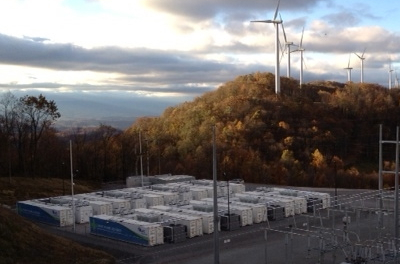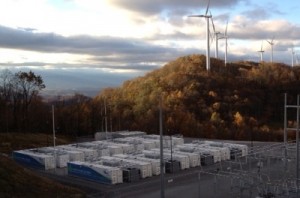
A huge battery bank connected to a wind farm was officially commissioned today in a project that makes wind power more closely resemble a traditional power plant.
Two divisions of energy project developer AES today said that the 98-megawatt Laurel Mountain wind facility in West Virginia is now connected to 32 megawatts worth of lithium ion batteries from A123 Systems. It’s the largest project to couple wind power with lithium ion batteries, according to the company.
The shipping container-size batteries will allow AES to gradually adjust power delivery to the grid up and down, rather than have a more sudden drop-off in power due to a change in wind. The variability of wind and solar can make integrating large amounts of renewable energy challenging to grid operators.
More significant from a commercial point of view is that the battery operations will be selling frequency regulation services to local grid operator PJM. The batteries will supply 32 megawatts of power in quick bursts to maintain an even balance between power supply and demand on the grid, displacing a job which had been done by a natural gas power plant.
The scale of the project demonstrates that batteries can be cost-effective for grid storage and can be used for different applications, such as supplying power to the grid during peak times when the price is highest, said AES Energy Storage president Chris Shelton.
There are 16 shipping containers, each of which can supply two megawatts for up to 15 minutes. AES chose lithium ion batteries because they were the least expensive for this application and they are proven in the auto industry, Shelton said.
“If you can charge and discharge them in 15 minutes, it’s not hard to think you could do it over an hour or four hours–you just add more batteries,” he said. “We see the costs of the (lithium ion battery) technology decline over time because of the focus on electric vehicles and the batteries are getting smaller, better, and cheaper.”
After little activity for years, grid storage has sped up over the past few years, aided by stimulus grants to test technologies to buffer renewable energy or provide back-up power.
At the Laurel Mountain project, the batteries will be connected to 61 mountaintop wind turbines each of has a generating capacity of 1.6 megawatts.
“Combining wind and solar with storage provides the greatest benefit to grid operations and has the potential to achieve the greatest economic value,” said PJM president and CEO Terry Boston in a statement who called energy storage the “silver bullet” for solving the problems of variability in power.
Via: cnet

 Follow
Follow